
Today’s journey in the JacoBLOG time machine is a short hop, skip, and a jump back to mid-December 2022 – just two years back in time. But as you’ll read, we may have nailed a trend that’s been in full bloom over the past 24 months.
A trend toward actual experiences – going places, doing things, being there live in the flesh. IRL.
While WFH is still a “thing,” we’re clearly seeing our recreational lives full of travel, concerts, sports, and events – the kind of activities you want to be there for. IRL.
How can radio deliver more on that premise and promise, whether it’s in the contest and giveaway department OR having real people, in the studio, in real time, connecting with audiences in meaningful ways? While this continues to be an imperative for commercial radio, public radio may be feeling the effects of too many recorded shows on the schedule. When we query listeners, they continue to point to events, activities, and engagement. IRL.
And over in Christian radio, much of the platform’s success over these last two years may be attributable to “being there” for listeners in need – those who are feeling the pressure, anxiety, depression, and hopelessness. Many will tell you how their favorite station answered their prayers with the right song at the right time that inspired and elevated them spiritually.
It’s the power of radio – IRL – and the ability to be in the moment, present, and real. As the medium grapples with fundamental concerts here in late 2024, maybe some of the points mentioned in today’s post will resonate for you. – FJ
There’s nothing more frustrating than “shrinkage.” That’s the lesson we learned on Seinfeld in an episode called “The Hamptons” (season 5, episode 21). It’s a classic where George is humiliated over a “shrinkage” moment after going swimming. (See the end of this post for the clip.)
It’s never fun when things aren’t as big as they seem to be. That’s especially true with the so-called “media pie” – the collective mass of media that includes all forms of audio and video.
Now we have SVODs, podcasts, social media, e-readers, short and long-form video, and all sorts of media choices that didn’t exist a couple of decades or so ago. And in each of these categories, we’ve absorbed the expansion of content. Now there aren’t thousands of podcasts – there are millions of them. Where there was just Facebook and MySpace, we now have generational social media channels to meet every need.
And the experts have told us consumption has continued to grow. While there have been warnings about ultimately reaching “peak content,” producers, showrunners, game designers, and videographers keep cranking out more and more media to consume in order to meet our insatiable needs and desires.
But what if all that content has actually had the opposite effect? It may sound like a case of “cognitive dissonance” where we are confronted with facts that seemingly contradict common sense and the facts we have at hand.
That’s why when I saw a research study by the respected IPG Magna that upends our conventional wisdom, it caught me off guard. Covered by both MediaPost and Inside Radio, “The Media Time Paradox” is a mysterious research study that flies in the face of what we’ve been told – especially since COVID.
Our logic suggests that when the lockdowns that started in March 2020 began, we hunkered down at home – watching Netflix, making Spotify playlists, listening to podcasts, and doom strolling like never before on social media.
But Magna insists that’s not really so. And in fact their consumer tracking data indicates a drop of more than 11% in time spent using media since 2019, continuing to head south through this year.
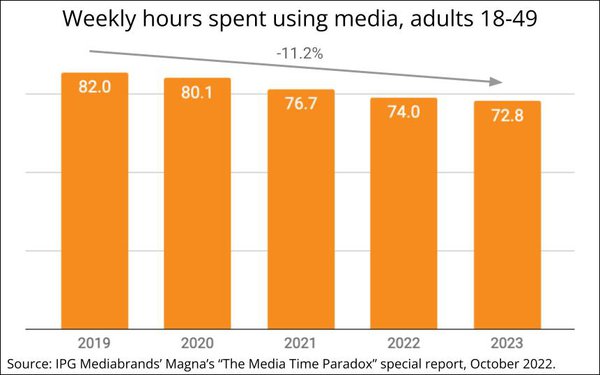
And projections for next year point to another drop, this time nearly 2%. It’s not a freefall by any means, but the data suggests we may be looking at our world of expanded media all wrong.
So what explains this modern day version of Firesign Theatre’s aptly named Everything You Know Is Wrong album (one of the greatest titles ever)? Their data even shows TikTok is slowing down as people spend less time on the platform.
The guy who owns this study at Magna is EVP of Audience Intelligence Brian Hughes. He says, “TikTok keeps getting new users, but the new users are older and older people who spend less time on TikTok overall.”
older people who spend less time on TikTok overall.”
MediaPost points out TikTok has fallen in TSS (Time Spent Socializing – my acronym) by a precipitous 42% since its height in 2020 – the year of huddling together at home.
The chart below breaks out 18-49 year-old U.S. adults. Only “on-demand TV” and “mobile” show increases in weekly hours consumed. “Radio” (and we can only assume it’s broadcast) is down a whopping 21% since 2019, and has dropped 3% since 2021.
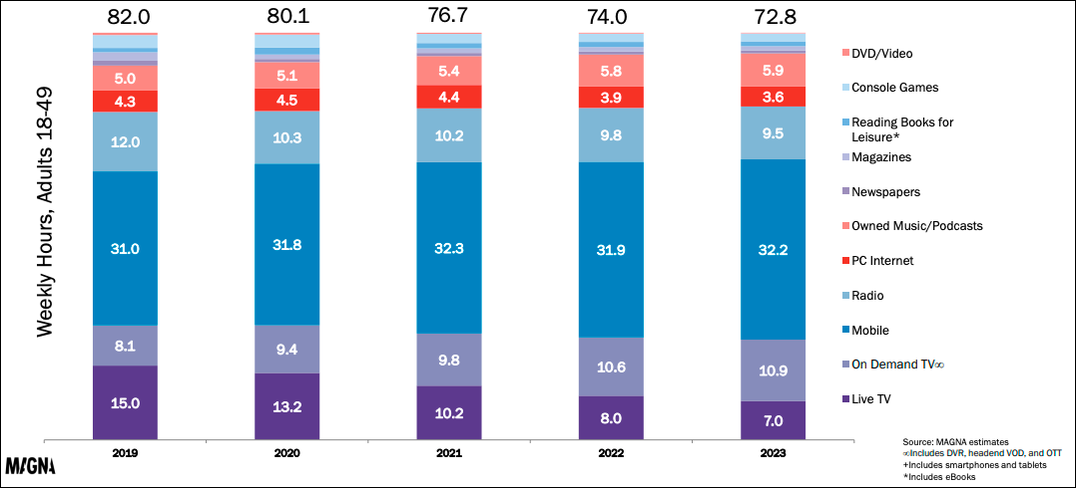
Hughes attributes these falloffs to “burnout” (especially for social media), and a renewed urge to enjoy experiences IRL (in real life).
Now, no one gets more rankled than me by “black swan” research that goes against the grain of so many other studies. But in the case of our Techsurveys – conducted among mostly radio fans – we’ve tracked the slippage as well.
 In our analyses, I’ve talked about the “slow leak” that has impacted broadcast radio listening, especially in the car. We’ve attributed the drop to less commuting (although it has come back a long way since those dark days of 2020), but also in-car infotainment systems offering greatly expanded driver and passenger choices.
In our analyses, I’ve talked about the “slow leak” that has impacted broadcast radio listening, especially in the car. We’ve attributed the drop to less commuting (although it has come back a long way since those dark days of 2020), but also in-car infotainment systems offering greatly expanded driver and passenger choices.
Is the “IRL boom” real? Are consumers seeking actual experiences rather than virtual ones? Those who work in travel and tourism or the concert industry have had remarkably robust years. Plans that were put off – for expensive trips, weddings and family celebrations, and “bucket list” items – have come roaring back this year.
actual experiences rather than virtual ones? Those who work in travel and tourism or the concert industry have had remarkably robust years. Plans that were put off – for expensive trips, weddings and family celebrations, and “bucket list” items – have come roaring back this year.
Earlier this fall, MediaPost’s Joe Mandese wrote a story titled, “Experiential Rebounds, Surges Double-Digits In Years Following Pandemic.”
The chart below from PQ Media clearly illustrates Hughes’ theory about consumers spending less time on their screens and a renewed focus on IRL experiences. Sponsorships and live event marketing are clearly bouncing back from the scourge of COVID:
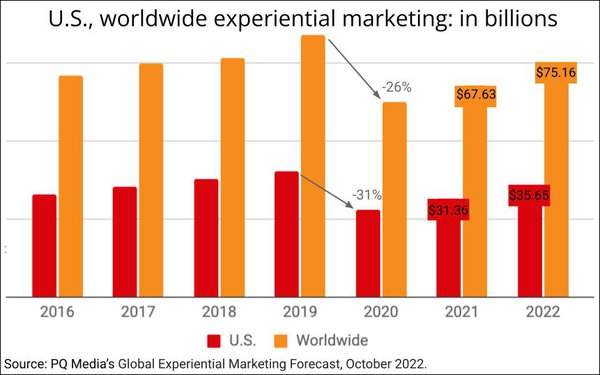
And so for radio, the Magna study suggests a renewed focus on the experiential – meet & greets, concert trips, station open houses, and other events that bring audiences and stations together.
The pieces are already in place. Local radio is one of the few media categories that can offer experiences to hometown listeners – right now, “Christmas Wish” promotions dot the airwaves, while stations give away vacations, concert tickets, and other IRL prizes that “print.”
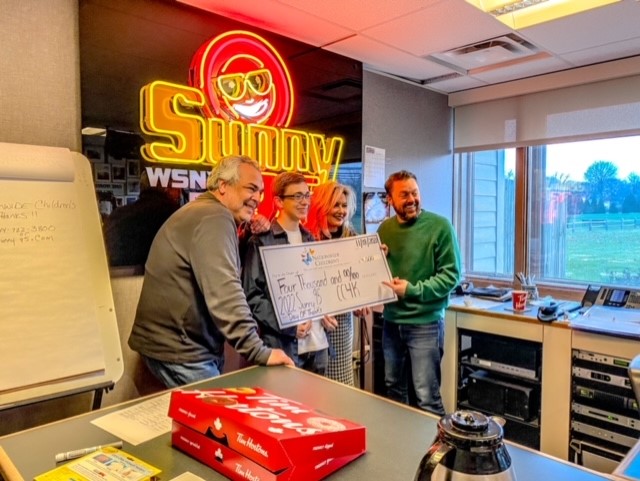 Does it get any more “real” than when your station raises hundreds of thousands of dollars during a Children’s Miracle Network Hospitals “Radiothon” to support sick kids in your community?
Does it get any more “real” than when your station raises hundreds of thousands of dollars during a Children’s Miracle Network Hospitals “Radiothon” to support sick kids in your community?
Or when that key starts that new car or truck? Or you give hundreds of listeners the chance to see that new movie before it opens to the public? Or when you give away front row seats to the big concert? Or sponsor your own free concert series or music festival?
For years, listeners talked about these experiences. And now, they proudly display them to friends, family, and the world on social media.
I know….”cash is king.” And in inflationary times, that might even be more true. But when radio was in its heyday, even cash contests activated the senses. Rather than the bland simplicity of text-to-win, promotions like “The Birthday Game” activated the imaginations of millions, making winning cash bigger than life.
was in its heyday, even cash contests activated the senses. Rather than the bland simplicity of text-to-win, promotions like “The Birthday Game” activated the imaginations of millions, making winning cash bigger than life.
In these strange times, radio has the opportunity to forge stronger connections by providing creative experiences that make listeners feel good about their lives. The signs are pointing in the right direction.
This chart from Techsurvey 2022 last winter underscores radio’s ability to strengthen listener connections post-COVID. Note how strong agreement with the statement, “I feel a sense of connection to the station that sent me this survey” reached new highs the past couple years.
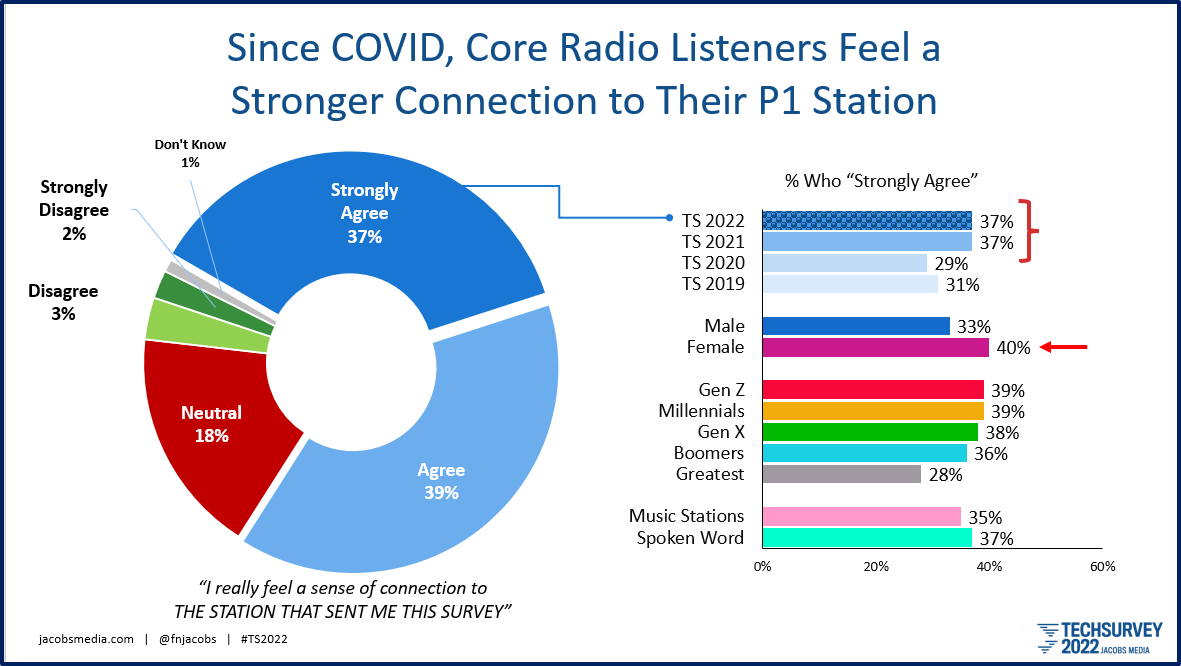 We’ll be tracking this question in next year’s Techsurvey, going into the field early next month. I’m hopeful we’ll see these numbers hold – or grow.
We’ll be tracking this question in next year’s Techsurvey, going into the field early next month. I’m hopeful we’ll see these numbers hold – or grow.
There’s a lot to be said for experiencing life again, especially after an incident that dragged everybody down for most of a couple years.
Radio broadcasters might discover a new formula for generating loyalty and passion:

To sign your station up for Techsurvey 2025, click here.
And now as promised, “Shrinkage.”
- Media And Technology In 2025: Believe It Or Not! - April 18, 2025
- In Radio, You Just Never Know - April 17, 2025
- The Secret To Making A Great Podcast (And Great Radio) - April 16, 2025





I don’t know how you guys walk around with those things.
The key is not to overthink it.